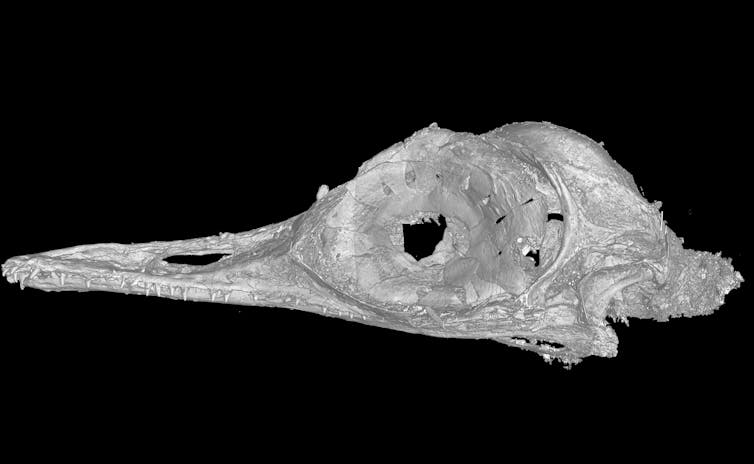The head of a tiny lizard that is hardly bigger than a bee hummingbird has been discovered in 99-million-year-old amber.
The piece of polished amber, just 31mm by 20mm by 8.5mm, was found in Kachin Province of northern Myanmar, an area becoming increasingly well-known for its remarkable amber-encased fossils.
This exciting little fossil creature is named Oculudentavis khaungraae, and is from the middle of the Cretaceous period, from a stage known as the Cenomanian. The skull looks remarkably bird-like and a number of features suggested that Oculudentavis might actually be related to the early ancestors of modern birds.
That would make this fossil the smallest dinosaur ever discovered, and for a time this was what researchers thought, but a closer look revealed that it was actually probably a lizard. Among other details, Oculudentavis appeared to possess teeth that were fused to the jaw bone, whereas dinosaur teeth sit in bony sockets. The fossil appears to have preserved some of the lizard’s original bodily material, allowing another team of scientists to spot the error and issue a correction.
The researchers from China and the US who studied the fossil subjected it to CT analysis (computed tomography, which uses X-rays to produce a series of cross-section images of a specimen) to examine the internal structure. But the amber is sufficiently clear that many of the features can be seen with the naked eye and a hand lens.
Oculudentavis has a long slender snout, a mouthful of needle-sharp teeth and massive eyes. Unlike most fossils, in which the original material is replaced by other minerals, the skull still appears to be composed of actual bone, although its microstructure and possible cell content have yet to be analysed.
Some of the skin of the palate and the tongue is also preserved, including the small pointed papillae on its surface. These may have worked in the same way as modern passerine birds such as the robin, whose tongue bumps are directed backwards and prevent prey escaping from the mouth.
Sadly the rest of the animal’s body is not preserved – some of the organic material decayed to produce what is now a yucky mess. Perhaps it exists in another amber fragment awaiting discovery.
One particularly revealing feature is the skull’s huge orbit (eye socket). A circle of tiny bony plates known as a sclerotic ring is arranged within the orbit, forming a cone with an inner circle that indicates the creature would have had a very small pupil. This kind of eye is typical of many lizards of today that are active during the day and sleep at night, suggesting that Oculudentavis had a similar “diurnal” schedule.
Significant find
The discovery of Oculudentavis is all the more fascinating because it was found in amber. Almost all fossils are formed from the hard remains of animals and plants: bones, teeth, shells and wood. But the amber has preserved some of the soft tissues of the lizard, making it a very unlikely fossil.
Amber starts off as a sticky liquid resin oozing from wounds on trees. But as volatile chemicals evaporate from its surface, the resin hardens into lumps that take some hammering to remove from the tree. This means it is even more unlikely that such an ancient creature would get preserved in amber. The largest piece of amber ever discovered weighs a mere 15kg.

The fossilised remains of Oculudentavis will be rich in all sorts of chemical decay products that can often be traced back to original biomolecules. Unfortunately it is doubtful that any DNA remains. DNA is such a delicate molecule that it rarely survives more than a few thousand years in humans, perhaps as much as 17,000 years in other animals and just maybe around a million years in fossilised bacteria.
Oculudentavis isn’t the first creature to be found in amber. In 2016, researchers reported a piece of amber also from Myanmar with the tail of feathered dinosaur.
Oculudentavis may not have turned out to be a mini dinosaur, but it’s still an amazing discovery. And who knows, one day we might yet find more dinosaur fragments in amber.
This article was amended on March 26 to correct errors following the misidentification of Oculudentavis as a dinosaur.

